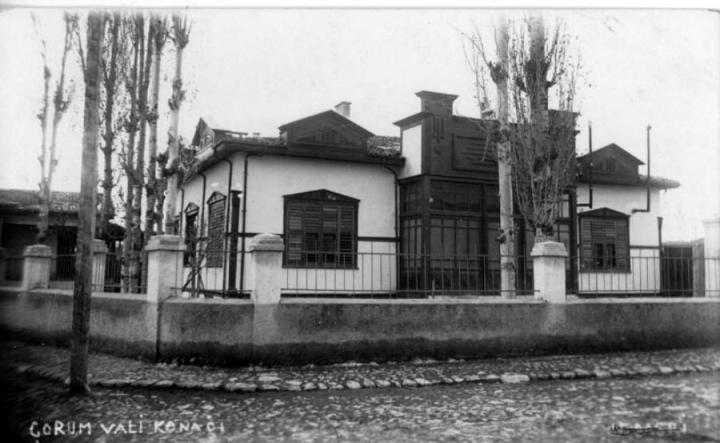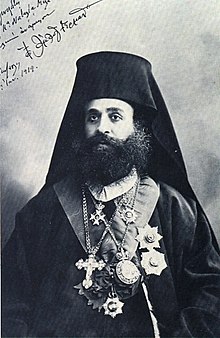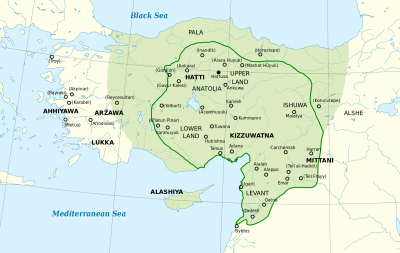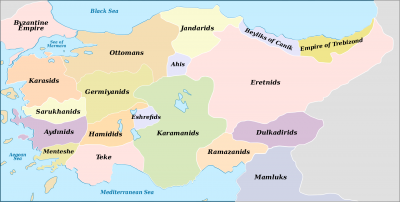Toponym
The name Çorum is of Armenian origin and can be traced in Ottoman documents from the 16th century.[1] The medieval Greek placename was Ευχάνεια (Euchaneia).
History
The history of the area around the present-day city goes back to the Paleolithic ages, with small settlements and tools from the era variously having been excavated over the past century.
The town also seems to have been an Assyrian trading post acting as a connection between Anatolia and Mesopotamia between 1950 and 1850 B.C.
The city and surrounding area rose to prominence with the emergence of the Hittite Empire between 1650-1200 B.C., under the patronage of which the arts and local economy significantly developed and prospered. Hattusa, the capital of Hittite Empire, was located in the region owing to its inherent geographic protection, and the well-established local economy as supported by the regional Karum system.
Following the collapse of the Hittites, the Phrygian Empire continued to keep stability in the region.
After the Phrygians, the city underwent various rulerships, with the most prominent being Urartu, the Medes, the Persians, Macedonians, Galatians, the Romans, the Byzantines, the Seljuks, and ultimately the Ottomans in the fourteenth century.
In the early twentieth century, during the Turkish War of Independence, Çorum was among the cities with the highest count of Turkish casualties, with 1510 Medals of Independence being awarded to troops from the city and its surrounding villages.
In 1980, radical Sunni Muslims perpetrated the Çorum Massacre against the Alevis, killing 57 and injuring more than 200.
Christian Population
“The 3,520 Armenians in the kaza of Çorum lived in five localities: 1,020 in Çorum, 1,500 in Ekrek, and the rest in Bozok, Hüseyinabad, and Alaca (pop. 400).”[2]
List of the Greek inhabited settlements
Τσορούμ – Tsoroum [Çorum]
Αγτζάκουγιουμ – Agtsakouyum
Ακπουνάρ – Akpounar [Akbunar]
Γεντίκιοζ – Yentikioz
Καρατζάορεν – Karatsaoren
Κιούρουτζεκ – Kiouroutsek
Ογιμάαγατς – Oyimaagats
Σαρίκαγια – Sarikayia
Τιβάνκιοϊ – Tivankioy [Divanköy]
Χιτίρκιοϊ – Hitirkioy [Hıtırköy][3]
Destruction
A group of 300 young Armenians who were deported from Merzifon (province of Sivas) in mid-June 1915, was escorted to Elek Deresi near the village of Tenik on route from Çorum, under the direct supervision of Faik Bey, the kaymakam, and Mahir Bey, the commander of the gendarmerie. They were stripped and hacked to death with axes. In the following days the remaining 900 male Armenian deportees from Merzifon suffered the same fate.[4]
“With the exception of the first convoy from Çorum, which set out early in July [1915] for the Syrian deserts by way of Boğazlian [Boğazlıyan] and Bozanti, the groups of deportees were liquidated by çetes [irregulars] from Angora [Ankara] under the supervision of the kaymakam Nureddin Bey, who held his post from 22 November 1913 to 27 March 1916.”[5]

Çorum Town
It lies on the edge of a fertile plain.
A historic town on old trade routes from central Anatolia to the Black Sea coast, Çorum became famous for its hand-spinning and weaving cottage industries, the manufacture of copper utensils, and its leather products. It is also the main trading centre for the surrounding plain; the plain, watered by the Kızıl River (the ancient Halys), produces cereals, fruits, tobacco, and sugar beets.
History
In the period from 5000 to 3000 B.C., the first human settlements were established in the Çorum area. According to the excavations in Alacahöyük, Balımsultan köyü, Büyük Güllücek, Boğazkale, Eskiyapar, Hüseyindede and Kuşsaray, this region was technically and culturally advanced due to the nearby large deposits of raw materials.
In the Bronze Age (3000-1000 B.C.), numerous settlements were established in the region around Çorum. Around 2000 B.C. the Hattians lived here. In the period from about 1950-1850 B.C., trading colonies of the Assyrians existed in this area. The Hittites ruled here from about 1650 to 1200 B.C.
In the later centuries after that, Çorum shared the history of Cappadocia. Thus, the Phrygians, Persians, Macedonians, Romans, Byzantines and other peoples ruled here. After the Battle of Man(t)zikert in 1071, the Seljuk Turks conquered the region and made it part of the Beylik of the Danishmends. Several changes of power between Rum Seljuks and Danishmends followed. After 1243, the region temporarily came under Mongol suzerainty. From the 1360s, Çorum was under the rule of Emir Hacı Sadgeldi as part of the Ottoman Empire.
Destruction

In the same year 1917, the C.U.P. regime made the area between Çorum and Ankara a deportation area for Greeks from Samsun. The Austrian consul at Samsun, Ernst von Kwiatkowski, reported:
“At the end of December [1917], the evacuation of Greek villages started. The villagers were given a short time in which to sell their property at very low prices and to Turkish buyers only. The few thousand displaced people were taken to Bafra and then inland, via Samsun. The few survivors are going to settle in the area between Çorum and Ankara. (…)
Presently, thousands of people from the fertile region where excellent tobacco is produced, are marching to certain death; as a consequence, this region is sure to become impoverished.”[7]
On 1 October 1917, shortly before his departure from Trebizond, in a concise report E. von Kwiatkowski estimated the number of deportees to be between 80 and 100 thousand people: “‘With the hundreds of newly-dug graves, the Sungurlu cemetery provides an indication of the number of Greeks (in excess of 500) who died there from hunger, typhus, or the cold. Some children are still roaming the streets, more closely akin to animals than humans’ (letter dated July 20, 1917). In another letter, we are informed that: ‘Most of the Greek deportees have been transported from Çorum to Kangri. Only one group was sent to Ankara. I met those people as they were about to reach Ankara; of the initial 540, only 170 remained and they were in a pathetic situation’ (letter dated February 18, 1918).”[8]

